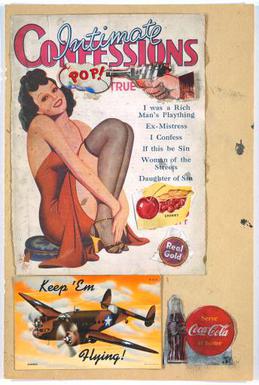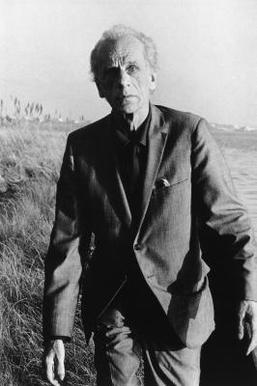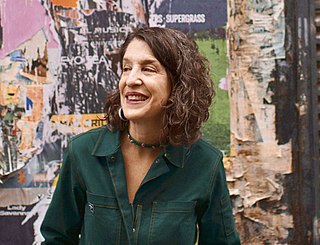
Pop art is an art movement that emerged in the United Kingdom and the United States during the mid- to late-1950s. The movement presented a challenge to traditions of fine art by including imagery from popular and mass culture, such as advertising, comic books and mundane mass-produced objects. One of its aims is to use images of popular culture in art, emphasizing the banal or kitschy elements of any culture, most often through the use of irony. It is also associated with the artists' use of mechanical means of reproduction or rendering techniques. In pop art, material is sometimes visually removed from its known context, isolated, or combined with unrelated material.

The Atomic Cafe is a 1982 American documentary film directed by Kevin Rafferty, Jayne Loader and Pierce Rafferty. It is a compilation of clips from newsreels, military training films, and other footage produced in the United States early in the Cold War on the subject of nuclear warfare. Without any narration, the footage is edited and presented in a manner to demonstrate how misinformation and propaganda was used by the U.S. government and popular culture to ease fears about nuclear weapons among the American public.

Joseph Cornell was an American visual artist and filmmaker, one of the pioneers and most celebrated exponents of assemblage. Influenced by the Surrealists, he was also an avant-garde experimental filmmaker. He was largely self-taught in his artistic efforts, and improvised his own original style incorporating cast-off and discarded artifacts. He lived most of his life in relative physical isolation, caring for his mother and his disabled brother at home, but remained aware of and in contact with other contemporary artists.

Raymond Edward "Ray" Johnson was an American artist. Known primarily as a collagist and correspondence artist, he was a seminal figure in the history of Neo-Dada and early Pop art and was described as "New York's most famous unknown artist". Johnson also staged and participated in early performance art events as the founder of a far-ranging mail art network – the New York Correspondence School – which picked up momentum in the 1960s and is still active today. He is occasionally associated with members of the Fluxus movement but was never a member. He lived in New York City from 1949 to 1968, when he moved to a small town in Long Island and remained there until his suicide.
Cinéma vérité is a style of documentary filmmaking developed by Edgar Morin and Jean Rouch, inspired by Dziga Vertov's theory about Kino-Pravda. It combines improvisation with use of the camera to unveil truth or highlight subjects hidden behind reality. It is sometimes called observational cinema, if understood as pure direct cinema: mainly without a narrator's voice-over. There are subtle, yet important, differences between terms expressing similar concepts. Direct cinema is largely concerned with the recording of events in which the subject and audience become unaware of the camera's presence: operating within what Bill Nichols, an American historian and theoretician of documentary film, calls the "observational mode", a fly on the wall. Many therefore see a paradox in drawing attention away from the presence of the camera and simultaneously interfering in the reality it registers when attempting to discover a cinematic truth.

The Cremaster Cycle is a series of five feature-length films, together with related sculptures, photographs, drawings, and artist's books, created by American visual artist and filmmaker Matthew Barney.

Richard Stuart Linklater is an American film director, producer, and screenwriter. He is known for making films that deal thematically with suburban culture and the effects of the passage of time. His films include the comedies Slacker (1990) and Dazed and Confused (1993); the Before trilogy of romance films: Before Sunrise (1995), Before Sunset (2004), and Before Midnight (2013); the music-themed comedy School of Rock (2003); the adult animated films Waking Life (2001), A Scanner Darkly (2006), and Apollo 10 1⁄2: A Space Age Childhood (2022); the coming-of-age drama Boyhood (2014); the comedy film Everybody Wants Some!! (2016); and the romantic comedy Hit Man (2023).
Bruce Conner was an American artist who worked with assemblage, film, drawing, sculpture, painting, collage, and photography.

Charles Henri Ford was an American poet, novelist, diarist, filmmaker, photographer, and collage artist. He published more than a dozen collections of poetry, exhibited his artwork in Europe and the United States, edited the Surrealist magazine View (1940–1947) in New York City, and directed an experimental film. He was the partner of the artist Pavel Tchelitchew.

Mark Rappaport is an American independent/underground film director and film critic, who has been working since the 1960s.

The Full Frame Documentary Film Festival is an annual international event dedicated to the theatrical exhibition of non-fiction cinema founded by Nancy Buirski, a Pulitzer Prize-winning photo editor of The New York Times and documentary filmmaker.
David Seals was an American writer.
Stuart Klawans has been the film critic for The Nation since 1988. He also writes a column on the visual arts for The New York Daily News.
Su Friedrich is an American avant-garde film director, producer, writer, and cinematographer. She has been a leading figure in avant-garde filmmaking and a pivotal force in the establishment of Queer Cinema.
Cosmic Ray is a 1962 American experimental short film directed by Bruce Conner. With both found footage and original material, it features images of countdown leader, a nude woman dancing, a Mickey Mouse cartoon, and military exercises. It is soundtracked by a performance of Ray Charles's "What'd I Say" and has been recognized by some critics as one of the first music videos.

Lynne Sachs is an American experimental filmmaker and poet living in Brooklyn, New York. Her moving image work ranges from documentaries, to essay films, to experimental shorts, to hybrid live performances. Working from a feminist perspective, Sachs weaves together social criticism with personal subjectivity. Her films embrace a radical use of archives, performance and intricate sound work. Between 2013 and 2020, she collaborated with musician and sound artist Stephen Vitiello on five films.

Kirsten Johnson is an American documentary filmmaker and cinematographer. She is mostly known for her camera work on several well-known feature-length documentaries such as Citizenfour and The Oath. In 2016, she released Cameraperson, a film which consists of various pieces of footage from her decades of work all over the world as a documentary cinematographer. Directed by Johnson herself, Cameraperson went on to be praised for its handling of themes about documentary ethics interwoven with Johnson's personal reflection on her experiences.
Victor Colicchio is an actor, screenwriter, musician, and songwriter. His screenwriting credits include Summer of Sam, co-written with actor Michael Imperioli and director Spike Lee, and High Times' Potluck. As an actor his credits include Inside Man, The Brave One, Goodfellas, The Deli, Bullets over Broadway, The Sopranos, and five episodes of Law & Order. He also played Slick Rick in New York Undercover. In the 1970s he was involved with New York film collective Total Impact. He also directed the documentary Rockin' America, about a multi-band tour of the US that suffers serious problems when the promoter quits. Colicchio founded Venice Film Production with his then-wife the producer Jeri Carroll.
Andrew Lambdin Moore is an American photographer and filmmaker known for large format color photographs of Detroit, Cuba, Russia, the American High Plains, and New York's Times Square theaters. Moore's photographs employ the formal vocabularies of architectural and landscape photography and the narrative approaches of documentary photography and journalism to detail remnants of societies in transition. His photographic essays have been published in monographs, anthologies, and magazines including The New York Times Magazine, Time, The New Yorker, National Geographic, Harper's Magazine, The New York Review of Books, Fortune, Wired, and Art in America. Moore's video work has been featured on PBS and MTV; his feature-length documentary about the artist Ray Johnson, How to Draw a Bunny, won the Special Jury Prize at the 2002 Sundance Film Festival. Moore teaches in the MFA Photography, Video and Related Media program at the School of Visual Arts in New York.

Obit is a 2016 documentary film about the obituary writers at The New York Times.












